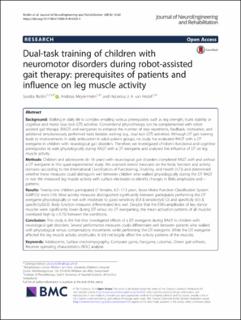Bitte benutzen Sie diese Kennung, um auf die Ressource zu verweisen:
https://doi.org/10.21256/zhaw-28452| Publikationstyp: | Beitrag in wissenschaftlicher Zeitschrift |
| Art der Begutachtung: | Peer review (Publikation) |
| Titel: | Dual-task training of children with neuromotor disorders during robot-assisted gait therapy : prerequisites of patients and influence on leg muscle activity |
| Autor/-in: | Ricklin, Sandra Meyer-Heim, Andreas van Hedel, Hubertus J. A. |
| et. al: | No |
| DOI: | 10.1186/s12984-018-0426-3 10.21256/zhaw-28452 |
| Erschienen in: | Journal of NeuroEngineering and Rehabilitation |
| Band(Heft): | 15 |
| Seite(n): | 82 |
| Erscheinungsdatum: | 17-Sep-2018 |
| Verlag / Hrsg. Institution: | BioMed Central |
| ISSN: | 1743-0003 |
| Sprache: | Englisch |
| Schlagwörter: | Adolescent; Computer game; Driven gait orthosis; Exergame; Lokomat; Receiver operating characteristics (ROC) analysis; Surface electromyography |
| Fachgebiet (DDC): | 615.82: Physiotherapie 616.8: Neurologie und Krankheiten des Nervensystems |
| Zusammenfassung: | Walking in daily life is complex entailing various prerequisites such as leg strength, trunk stability or cognitive and motor dual task (DT) activities. Conventional physiotherapy can be complemented with robot-assisted gait therapy (RAGT) and exergames to enhance the number of step repetitions, feedback, motivation, and additional simultaneously performed tasks besides walking (e.g., dual-task (DT) activities). Although DT gait training leads to improvements in daily ambulation in adult patient groups, no study has evaluated RAGT with a DT exergame in children with neurological gait disorders. Therefore, we investigated children's functional and cognitive prerequisites to walk physiologically during RAGT with a DT exergame and analysed the influence of DT on leg muscle activity. |
| URI: | https://digitalcollection.zhaw.ch/handle/11475/28452 |
| Volltext Version: | Publizierte Version |
| Lizenz (gemäss Verlagsvertrag): | CC BY 4.0: Namensnennung 4.0 International |
| Departement: | Gesundheit |
| Organisationseinheit: | Institut für Physiotherapie (IPT) |
| Enthalten in den Sammlungen: | Publikationen Life Sciences und Facility Management |
Dateien zu dieser Ressource:
| Datei | Beschreibung | Größe | Format | |
|---|---|---|---|---|
| 2018_Ricklin-et-al_Dual-task-training-of-children-with-neuromotor-disorders.pdf | 891.55 kB | Adobe PDF |  Öffnen/Anzeigen |
Zur Langanzeige
Ricklin, S., Meyer-Heim, A., & van Hedel, H. J. A. (2018). Dual-task training of children with neuromotor disorders during robot-assisted gait therapy : prerequisites of patients and influence on leg muscle activity. Journal of NeuroEngineering and Rehabilitation, 15, 82. https://doi.org/10.1186/s12984-018-0426-3
Ricklin, S., Meyer-Heim, A. and van Hedel, H.J.A. (2018) ‘Dual-task training of children with neuromotor disorders during robot-assisted gait therapy : prerequisites of patients and influence on leg muscle activity’, Journal of NeuroEngineering and Rehabilitation, 15, p. 82. Available at: https://doi.org/10.1186/s12984-018-0426-3.
S. Ricklin, A. Meyer-Heim, and H. J. A. van Hedel, “Dual-task training of children with neuromotor disorders during robot-assisted gait therapy : prerequisites of patients and influence on leg muscle activity,” Journal of NeuroEngineering and Rehabilitation, vol. 15, p. 82, Sep. 2018, doi: 10.1186/s12984-018-0426-3.
RICKLIN, Sandra, Andreas MEYER-HEIM und Hubertus J. A. VAN HEDEL, 2018. Dual-task training of children with neuromotor disorders during robot-assisted gait therapy : prerequisites of patients and influence on leg muscle activity. Journal of NeuroEngineering and Rehabilitation. 17 September 2018. Bd. 15, S. 82. DOI 10.1186/s12984-018-0426-3
Ricklin, Sandra, Andreas Meyer-Heim, and Hubertus J. A. van Hedel. 2018. “Dual-Task Training of Children with Neuromotor Disorders during Robot-Assisted Gait Therapy : Prerequisites of Patients and Influence on Leg Muscle Activity.” Journal of NeuroEngineering and Rehabilitation 15 (September): 82. https://doi.org/10.1186/s12984-018-0426-3.
Ricklin, Sandra, et al. “Dual-Task Training of Children with Neuromotor Disorders during Robot-Assisted Gait Therapy : Prerequisites of Patients and Influence on Leg Muscle Activity.” Journal of NeuroEngineering and Rehabilitation, vol. 15, Sept. 2018, p. 82, https://doi.org/10.1186/s12984-018-0426-3.
Alle Ressourcen in diesem Repository sind urheberrechtlich geschützt, soweit nicht anderweitig angezeigt.